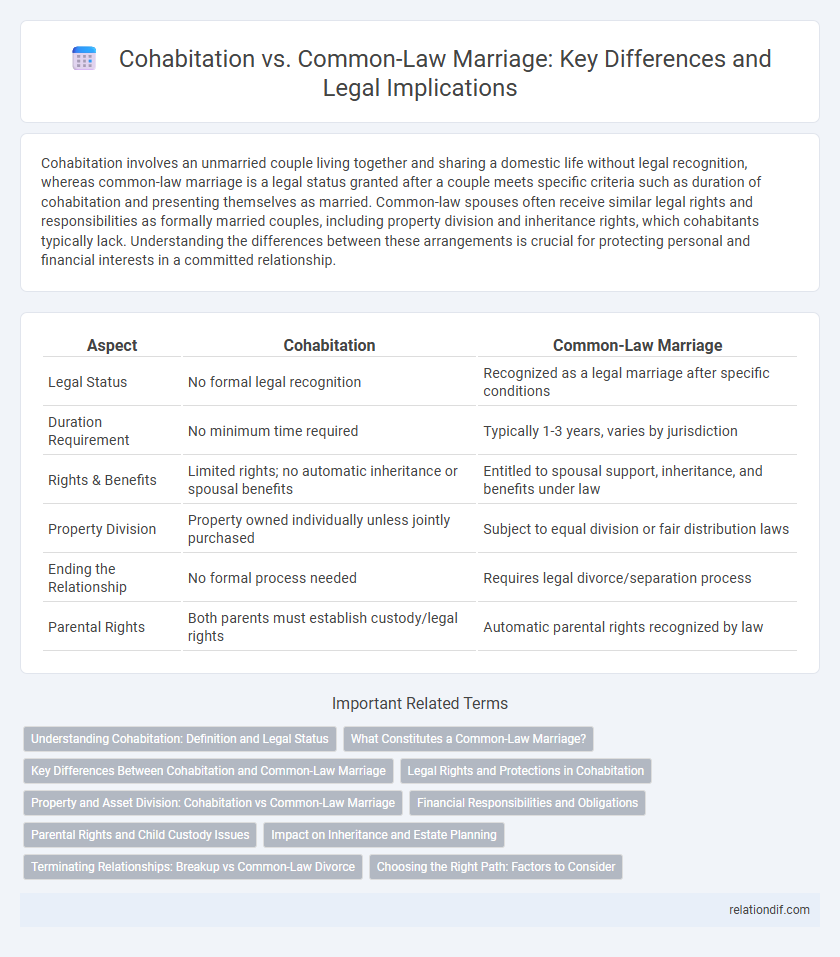Cohabitation involves an unmarried couple living together and sharing a domestic life without legal recognition, whereas common-law marriage is a legal status granted after a couple meets specific criteria such as duration of cohabitation and presenting themselves as married. Common-law spouses often receive similar legal rights and responsibilities as formally married couples, including property division and inheritance rights, which cohabitants typically lack. Understanding the differences between these arrangements is crucial for protecting personal and financial interests in a committed relationship.
Table of Comparison
| Aspect | Cohabitation | Common-Law Marriage |
|---|---|---|
| Legal Status | No formal legal recognition | Recognized as a legal marriage after specific conditions |
| Duration Requirement | No minimum time required | Typically 1-3 years, varies by jurisdiction |
| Rights & Benefits | Limited rights; no automatic inheritance or spousal benefits | Entitled to spousal support, inheritance, and benefits under law |
| Property Division | Property owned individually unless jointly purchased | Subject to equal division or fair distribution laws |
| Ending the Relationship | No formal process needed | Requires legal divorce/separation process |
| Parental Rights | Both parents must establish custody/legal rights | Automatic parental rights recognized by law |
Understanding Cohabitation: Definition and Legal Status
Cohabitation refers to two individuals living together in a romantic relationship without formal legal recognition as spouses. Unlike common-law marriage, which some jurisdictions recognize as legally equivalent to marriage after meeting specific criteria, cohabitation generally does not grant automatic legal rights or protections. Understanding the legal status of cohabitation is essential for partners to navigate property rights, inheritance, and contractual obligations.
What Constitutes a Common-Law Marriage?
Common-law marriage is defined by a couple living together for a significant period, presenting themselves publicly as spouses without formal registration or ceremony. Legal recognition requires meeting specific criteria such as cohabitation duration, mutual agreement to be married, and holding themselves out to the community as a married couple. Unlike mere cohabitation, common-law marriage grants couples similar legal rights and obligations as those who are formally married by statute.
Key Differences Between Cohabitation and Common-Law Marriage
Cohabitation involves two partners living together without legal recognition, whereas common-law marriage grants a couple similar legal rights and responsibilities as formal marriage after meeting specific criteria, such as cohabiting for a certain period. Key differences include property rights, inheritance, and spousal support, which are typically protected under common-law marriage but not in cohabitation. Courts often consider factors like intent to be married, public representation as a married couple, and duration of the relationship to determine common-law status.
Legal Rights and Protections in Cohabitation
Cohabitation involves couples living together without formal marriage, often lacking the comprehensive legal rights and protections granted in common-law marriages. Legal recognition of cohabiting partners varies significantly by jurisdiction, frequently limiting access to spousal benefits, inheritance rights, and property claims. Establishing cohabitation agreements or contracts can help protect individual rights and clarify financial responsibilities within the relationship.
Property and Asset Division: Cohabitation vs Common-Law Marriage
Property and asset division in cohabitation generally lacks automatic legal protections unless specified in a cohabitation agreement, often requiring proof of ownership or contribution for claims. Common-law marriage grants partners rights akin to legally married couples, including equitable distribution of property acquired during the relationship. Courts may consider factors like financial contribution, duration, and intent to determine asset division in common-law marriages, providing more structured legal recourse than standard cohabitation arrangements.
Financial Responsibilities and Obligations
Cohabitation involves couples living together without legal recognition, which means financial responsibilities and obligations are generally separate unless otherwise specified by contracts. Common-law marriage, recognized in some jurisdictions, grants partners similar financial rights and obligations as legally married couples, including shared assets, debts, and spousal support. Understanding the legal status of the relationship is crucial for managing property division, tax benefits, and financial liabilities.
Parental Rights and Child Custody Issues
In cases of cohabitation, parental rights and child custody are determined through legal agreements or court orders since cohabiting partners do not automatically share parental rights. Common-law marriage provides a legal status similar to formal marriage, granting partners parental rights and responsibilities, including automatic rights to child custody unless otherwise decided by a court. Courts prioritize the child's best interests by evaluating factors such as the parent's ability to provide care, emotional bonds, and stability, regardless of the couple's marital status.
Impact on Inheritance and Estate Planning
Cohabitation without formal recognition often complicates inheritance rights, as partners may lack automatic claims to property or assets without a will. Common-law marriage provides legal status similar to traditional marriage in many jurisdictions, granting partners inheritance rights and spousal benefits that simplify estate planning. Proper estate planning should address the nuances between cohabitation and common-law marriage to ensure asset distribution aligns with the couple's intentions and legal protections.
Terminating Relationships: Breakup vs Common-Law Divorce
Terminating a cohabitation relationship typically involves a straightforward breakup without legal formalities, whereas ending a common-law marriage requires a formal divorce process similar to that of legally married couples. Common-law divorce addresses the division of assets, child custody, and spousal support, ensuring legal protection for both parties. Understanding the distinction between breakup and common-law divorce is essential for managing rights and obligations during relationship dissolution.
Choosing the Right Path: Factors to Consider
When deciding between cohabitation and common-law marriage, it's essential to consider legal recognition, property rights, and financial responsibilities that vary significantly by jurisdiction. Common-law marriage often grants similar rights to traditional marriage, including inheritance and spousal support, whereas cohabitation typically lacks these protections unless formal agreements are established. Evaluating relationship duration, mutual intentions for commitment, and potential impact on taxes and healthcare decisions ensures an informed choice tailored to personal and legal needs.
Cohabitation vs Common-Law Marriage Infographic

 relationdif.com
relationdif.com